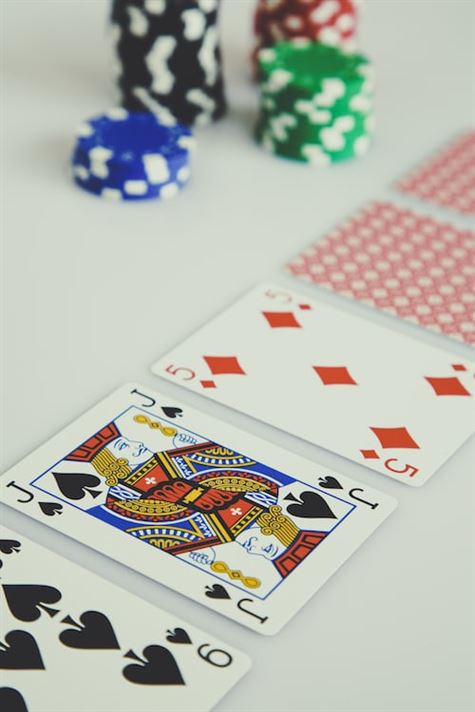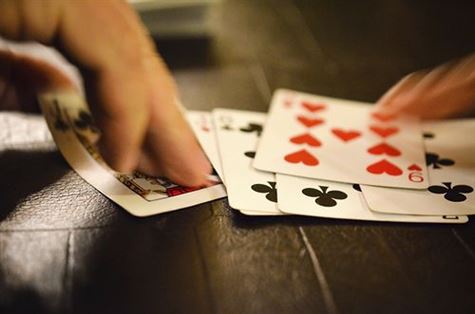Poker is a game of skill, strategy, and calculated decision-making. While luck plays a role, successful poker players understand the importance of leveraging mathematics to gain an edge over their opponents. By utilizing mathematical concepts such as probability, expected value, and game theory, players can make more informed decisions and increase their chances of winning. In this article, we will explore how mathematics can be applied to poker, providing players with the tools they need to put the odds in their favor and improve their overall performance at the table.
The Role of Probability in Poker: How Mathematics Can Help You Make Informed Decisions
At the heart of poker lies the concept of probability. Probability is the branch of mathematics that deals with the likelihood of events occurring. In poker, understanding probability allows players to make informed decisions based on the likelihood of certain outcomes.
One of the most fundamental concepts in poker is the concept of outs. Outs are the cards that can improve your hand and give you a winning combination. By calculating the number of outs you have, you can determine the probability of hitting one of those cards and make decisions accordingly.
For example, let’s say you have a flush draw, which means you have four cards of the same suit and need one more to complete the flush. There are 13 cards of each suit in a standard deck, and you already have four, so there are nine remaining cards that can complete your flush. With 47 unknown cards left in the deck, the probability of hitting your flush on the next card is approximately 19%.
Understanding the concept of pot odds is another crucial aspect of poker mathematics. Pot odds refer to the ratio of the current size of the pot to the cost of a contemplated call. By comparing the pot odds to the odds of completing your hand, you can determine whether it is profitable to continue playing.
For instance, if the pot is $100 and your opponent bets $20, you would need to call $20 to potentially win $120. If the odds of completing your hand are greater than 20%, it would be a profitable call in the long run. However, if the odds are lower, it would be a losing proposition.
Calculating pot odds and comparing them to the odds of completing your hand is a fundamental skill that all successful poker players possess. It allows them to make rational decisions based on mathematical probabilities rather than relying solely on intuition or luck.
Furthermore, understanding probability can also help you make better decisions when it comes to bluffing. Bluffing is a strategy used to deceive opponents into thinking you have a stronger hand than you actually do. By understanding the likelihood of certain hands being present based on the community cards and your opponents’ actions, you can determine the optimal times to bluff.
For example, if the community cards are such that it is unlikely for anyone to have a strong hand, bluffing becomes a more viable option. Conversely, if the community cards make it more likely for someone to have a strong hand, bluffing becomes riskier.
Calculating Pot Odds: Using Math to Determine Whether to Call, Raise, or Fold
To calculate pot odds, players need to consider two main factors: the current size of the pot and the cost of the bet. The pot size includes all the chips that have been bet by all the players in the hand. The cost of the bet refers to the amount of chips that a player needs to put into the pot to continue playing.
Once these two factors are known, players can calculate the pot odds by dividing the cost of the bet by the total pot size. For example, if the cost of the bet is 10 chips and the total pot size is 50 chips, the pot odds would be 10/50 or 1/5.
Pot odds can then be used to determine whether a player should call, raise, or fold. If the pot odds are greater than the odds of completing a winning hand, it is profitable to call. On the other hand, if the pot odds are lower than the odds of completing a winning hand, it is more profitable to fold. If the pot odds are equal to the odds of completing a winning hand, it is a break-even situation and the player can make a decision based on other factors such as their position at the table or their opponents’ playing styles.
Calculating pot odds requires a basic understanding of probability. Players need to know the number of outs they have, which are the cards that will improve their hand. For example, if a player has a flush draw with 9 outs, they have a roughly 36% chance of completing their flush by the river.
By comparing the pot odds to the odds of completing a winning hand, players can make more informed decisions. If the pot odds are higher than the odds of completing a winning hand, it is a profitable decision to call. If the pot odds are lower, it is more profitable to fold.
It is important to note that pot odds are not the only factor to consider when making a decision in poker. Players also need to consider their opponents’ playing styles, their position at the table, and the overall dynamics of the hand. However, by incorporating pot odds into their decision-making process, players can gain a significant edge over their opponents.
Game Theory and Poker: Applying Mathematical Strategies to Gain an Edge
One of the key mathematical concepts that can be applied to poker is game theory. Game theory is the study of strategic decision-making in situations where the outcome of one person’s decision depends on the decisions of others. In poker, this translates to understanding the probabilities and potential outcomes of different hands and using that knowledge to make informed decisions.
Probability is at the heart of game theory in poker. By understanding the likelihood of certain hands and outcomes, players can make more informed decisions about whether to bet, raise, or fold. For example, if a player knows that the probability of getting a flush on the river is low, they may choose to fold rather than continue betting on a losing hand.
Another mathematical concept that can be applied to poker is expected value. Expected value is a way of calculating the average outcome of a situation based on the probabilities and potential payoffs. In poker, this means calculating the expected value of different betting decisions to determine which one is most likely to result in a positive outcome.
To calculate expected value, players must consider the probability of each possible outcome and the potential payoff for each outcome. For example, if a player has a 50% chance of winning $100 and a 50% chance of losing $50, the expected value of that decision would be $25 ($100 * 0.5 – $50 * 0.5). By calculating the expected value of different betting decisions, players can make more strategic choices that maximize their potential winnings.
In addition to game theory and expected value, players can also leverage other mathematical concepts in poker. For example, understanding pot odds can help players determine whether a bet is worth making. Pot odds compare the current size of the pot to the cost of a contemplated call. If the pot odds are higher than the odds of completing a winning hand, it may be a good bet to make.
Furthermore, players can use mathematical concepts to analyze their opponents’ behavior and make predictions about their likely strategies. By observing patterns in betting, bluffing, and folding, players can gain insights into their opponents’ decision-making processes and adjust their own strategies accordingly.
The Mathematics of Bluffing: Understanding the Numbers Behind Successful Bluffs
Bluffing is a crucial part of poker, and it involves making your opponents believe that you have a stronger hand than you actually do. It is a risky move, as it requires you to bet or raise with a weak hand, hoping that your opponents will fold and give up their stronger hands. To be successful at bluffing, you need to understand the mathematics behind it.
One important concept in bluffing is pot odds. Pot odds refer to the ratio of the current size of the pot to the cost of a contemplated call. By calculating the pot odds, you can determine whether a bluff is profitable in the long run. For example, if the pot is $100 and your opponent bets $20, you would need to win the pot at least 20% of the time for your bluff to be profitable.
Another mathematical aspect of bluffing is the concept of expected value (EV). EV is a measure of the average amount of money you can expect to win or lose on a particular play over the long run. To calculate the EV of a bluff, you need to consider the probability of your bluff succeeding and the potential payoff if it does. If the expected value of your bluff is positive, it means that, on average, you will make money in the long run by making that bluff.
To determine the probability of your bluff succeeding, you need to consider the number of outs you have. Outs are the cards that can improve your hand and potentially make it stronger than your opponents’. For example, if you have a flush draw, there are nine cards left in the deck that can complete your flush. By calculating the number of outs and the number of cards remaining in the deck, you can estimate the probability of hitting your hand and decide whether it is worth bluffing.
Understanding the concept of equity is also crucial in bluffing. Equity refers to the share of the pot that belongs to you based on the strength of your hand. By comparing your equity to the size of the pot, you can determine whether a bluff is profitable. If your equity is higher than the pot odds, it means that you have a positive expectation and that bluffing is a profitable move.
It is important to note that bluffing should not be done randomly or without careful consideration. It requires a deep understanding of the game, your opponents’ tendencies, and the mathematical aspects involved. Bluffing too often or at the wrong times can be costly and can quickly deplete your chip stack.
Bankroll Management: Using Mathematical Principles to Optimize Your Poker Finances
One of the fundamental concepts in bankroll management is understanding variance. Variance refers to the natural fluctuations in your results over time. Even the best players in the world experience winning and losing streaks, and it is crucial to have a bankroll that can withstand these swings. By using mathematical formulas, you can calculate the optimal size of your bankroll based on your win rate and desired level of risk.
To determine the appropriate bankroll size, you need to consider two key factors: your win rate and the level of risk you are comfortable with. Your win rate is the average amount of money you expect to win per hour of play. This can be calculated by tracking your results over a significant sample size. The level of risk refers to the likelihood of going broke during a downswing. By using mathematical formulas, you can find the balance between these two factors and determine the optimal bankroll size.
One commonly used formula for bankroll management is the Kelly Criterion. Developed by mathematician John L. Kelly Jr., this formula helps determine the optimal percentage of your bankroll to wager on each hand. The Kelly Criterion takes into account your edge in the game, the odds being offered, and the size of your bankroll. By using this formula, you can maximize your long-term growth while minimizing the risk of ruin.
Another important aspect of bankroll management is setting stop-loss and stop-win limits. A stop-loss limit is the maximum amount of money you are willing to lose in a single session or day. By setting a stop-loss limit, you can prevent yourself from chasing losses and potentially going on tilt. Similarly, a stop-win limit is the maximum amount of money you are willing to win before calling it a day. By setting a stop-win limit, you can lock in your profits and avoid giving back your winnings.
In addition to bankroll management, mathematics can also be applied to decision-making at the table. One such concept is pot odds. Pot odds refer to the ratio of the current size of the pot to the cost of a contemplated call. By calculating the pot odds, you can determine whether a call is profitable in the long run. If the pot odds are greater than the odds of completing your hand, it is a mathematically correct decision to make the call.
Furthermore, understanding expected value (EV) is crucial in making optimal decisions. EV is a mathematical concept that represents the average amount of money you expect to win or lose on a particular play. By calculating the EV of different actions, you can make informed decisions that maximize your long-term profitability. For example, if a certain play has a positive EV, it is a profitable move in the long run, even if it may result in a short-term loss.
In conclusion, bankroll management is a critical aspect of poker that is often overlooked. By leveraging mathematical principles, you can optimize your poker finances and increase your chances of long-term profitability. Understanding variance, using formulas like the Kelly Criterion, and setting stop-loss and stop-win limits are all essential components of effective bankroll management. Additionally, applying mathematical concepts like pot odds and expected value can help you make optimal decisions at the table. By putting the odds in your favor through mathematics, you can take your poker game to the next level.




